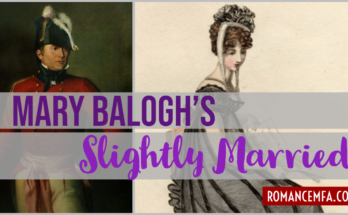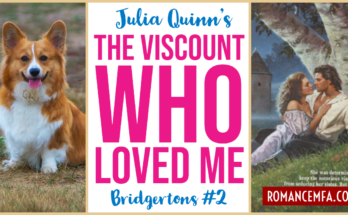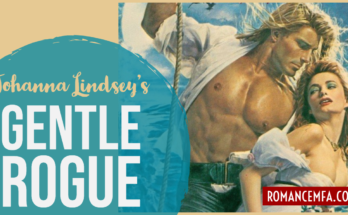Life isn’t fair. Just when I was getting back on top of things, the cold and flu season finally got me. Fortunately I was able to send my child to daycare and curl in bed with a book. Which book? The classic sickday book: S. Morgenstern’s Classic Tale of True Love and High Adventure, The Princess Bride, by William Goldman.
Book details:
Title: The Princess Bride
Author: William Goldman
Original publication date: 1973
Setting time & place: The European kingdom of Florin.
He is… about 25, a strong and handsome Farm Boy with a dream of making his fortune in America.
She is… an 18 year old milkmaid, also the most beautiful woman in the world.
Reasons to read this title: Goldman also wrote the screenplay of the much-beloved film, so you know what you’re getting in the print version, just with extra jokes.
My review of The Princess Bride
Is it a romance novel? Yes, with a HFN ending.
Is it a must read romance novel? No. It’s fun, but the movie is a bigger force in popular culture.
It’s always curious rereading something from my childhood. I had a 30th anniversary edition this time, with both 30th and 25th anniversary prologues by William Goldman, in which he details both the effect of the book on his family life through four generations, and his interactions with the lawyers of the Morgenstern Estate. It’s all very detailed, to the point where I had to double check on Wikipedia that yes, those parts are all fictional. Stephen King was not tapped to abridge Morgenstern’s sequel, Buttercup’s Baby, nor is he a descendant of a Florinese family, because Florin and Guilder are imaginary kingdoms. But when you’re already hopped up on Nyquil, it seems plausible.
The book has much more of this framing device wrapped around the story than the movie does — I’m going to have comparisons to the movie throughout — so I found myself fixated on that for a while. Goldman is not only telling us a story, he’s telling us a story about a story. It’s turtles all the way down. Before we even get to the love story, there’s something in there about the power of story because it’s entirely believable that this one (fictional) book has changed the course of four (fictional) generations of Goldman’s family. Books can do that.
The second thing that struck me about the book, which I don’t think I consciously took from previous reading or from the film, is the message that
Life Isn’t Fair
You may remember the line in the movie:
Well, in the book that line comes from Fezzik’s mother during the start of his wrestling career…
“Life is pain,” his mother said. “Anybody that says different is selling something.”
…and it’s just one of many many iterations of the message of fairness. He fairly beats the reader over the head with it. There’s even an aside from Goldman in the middle of the book about a childhood conversation with a friend’s mother, when Young Goldman is told that life isn’t fair, and then he repeats it, addressing the reader,
This book says ‘life isn’t fair’ and I’m telling you, one and all, you better believe it.
Look. (Grownups skip this paragraph.) I’m not about to tell you this book has a tragic ending, I already said in the very first line how it was my favorite in all the world. But there’s a lot of bad stuff coming up, torture you’ve already been prepared for, but there’s worse. There’s death coming up, and you better understand this: some of the wrong people die. Be ready for it. This isn’t Curious George Uses the Potty. Nobody warned me and it was my own fault (you’ll see what I mean in a little) and that was my mistake, so I’m not letting it happen to you. The wrong people die, some of them, and the reason is this: life is not fair. Forget all the garbage your parents put out. Remember Morgenstern. You’ll be a lot happier.
And, having warned the reader, Goldman kills off the hero. (If you’ve somehow missed the movie or book up until this point, I just spoiled it for you. Whoops!) And it’s not fair. Inigo, finding the body of the man in black in Zoo of Death, thinks,
It was too unfair. You expected unfairness if you breathed, but this went beyond that.
You know what happens, though – they get Miracle Max and bring Westley back and love triumphs and Fezzik finds some horses and they all ride off into the sunset.
Love has triumphed, there’s a bit more kissing in the movie. But that’s not the end in the book. In the book, they’ve only got Happy For Now.
However, this was before Inigo’s wound reopened, and Westley relapsed again, and Fezzik took the wrong turn, and Buttercup’s horse threw a shoe. And the night behind them was filled with the crescendoing sound of pursuit. . . .
And Goldman ends his final abridger’s note,
But I also have to say, for the umpty-umpth time, that life isn’t fair. It’s just fairer than death, that’s all.
Which is true. But also pretty much a downer and I don’t think many people come away from this story feeling down. It’s S. Morgenstern’s Classic Tale of True Love and High Adventure, after all, and I’m not the only one who grew up in the late 80s and can quote large portions of the screenplay. I’m pretty sure there’s a deeper message here. The message within the message, like the story within the story. And it has to do with Inconceivable!
Every time life is pain, life is suffering, life is unfair, the characters step up and do something inconceivable. They all know that life isn’t fair, but they keep fighting anyway. To wit, Inigo Montoya:
All the characters who come out ahead are the ones who worked for it. Inigo spent a decade plus training himself to become a wizard with a sword. Westley trained himself to become the Dread Pirate Roberts, as well as to develop a resistance to iocane powder. Fezzik, though he doesn’t even exercise, also has an extensive set of molding experiences in the book. Even Buttercup spends time perfecting herself, and three years in princess school in the book. It’s Humperdinck and Rugen and Vizzini, the characters who assume that life will be unfair in their favor, who are foiled again and again.
How’s that for a message? ‘Life isn’t fair, and it will be hard work, but if you keep at it you can get some happiness in there anyway.’
All in all, I’d say it’s a pretty good sick day book. When you are feeling low, and life is pain, and it’s inconceivable that you will ever be healthy again, it’s nice to know that inconceivable things happen!
I’ll be back next week to start in on the first reading from the Mid-Century Love Stories section of my syllabus: Gone With the Wind.



